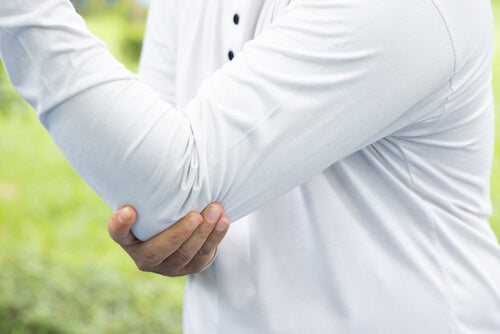Imagine being halfway through a perfect golf swing, only to feel a sharp, radiating pain in your elbow that stops you in your tracks. What you’re likely experiencing is golfer’s elbow (medial epicondylitis) – a condition that affects many athletes and individuals who engage in repetitive hand and wrist motions. While it may seem like a minor inconvenience at first, golfer’s elbow can severely impact your ability to perform day-to-day activities if not addressed properly.
You see, whether you play golf, tennis, or even partake in activities like gardening, this painful condition can severely limit your daily tasks. The discomfort and inflammation caused by golfer’s elbow are no joke, but the good news is that it’s treatable and, with the right prevention techniques, even avoidable.
What is Golfer’s Elbow and How is It Caused?
Golfer’s elbow was first identified in the early 19th Century, although at the time, it wasn’t specifically associated with the sport. Physicians began noting cases of individuals, mostly manual laborers, who experienced pain in their forearms and elbows from repetitive motions. As golf gained popularity in the 20th Century, the condition became more commonly associated with the sport, hence the name.
Now, golfer’s elbow is a form of tendinitis that occurs when the tendons attached to your forearm muscles to the inner part of your elbow become inflamed. The condition is caused by the repetitive stress placed on these tendons, often from gripping or swinging activities. While it's often associated with golf, it can affect anyone who performs repetitive arm movements, such as:
- Weightlifters
- Sports Players (football, basketball, baseball, hockey, tennis, etc.)
- Fishermen
- Carpenters
- Plumbers
- Painters
- Construction Workers
- Assembly Line Workers
- Butchers
- Cooks
- Regular Computer Users
- Gamers
- And More!
This condition is primarily caused by overuse, meaning any activity that strains the tendons in the elbow can cause damage over time. The inner elbow bears the brunt of excessive or poorly executed motions, leading to inflammation and pain. Without proper care or prevention, golfer’s elbow can worsen, making day-to-day activities unbearable.
How Do You Get Golfer’s Elbow and Its Symptoms?
Understanding how golfer’s elbow develops can help you prevent it. The injury often occurs when repetitive or forceful motions strain the muscles and tendons that control your hand and wrist. This stress leads to small tears and inflammation in the tendons, which causes pain.
The main symptoms of golfer’s elbow include:
-
Pain and Tenderness: This typically starts on the inner side of the elbow and may radiate down the forearm.
-
Stiffness: You may feel stiffness in your elbow, and making a fist can be painful.
-
Weakness: The muscles in your hands and wrists may weaken, making it difficult to grip objects or perform fine motor tasks.
-
Numbness or Tingling: Some people experience tingling sensations or numbness that radiates into the fingers, especially the ring and little fingers.
Symptoms can range from mild to severe and may develop gradually or suddenly, depending on the intensity of the activity.
Keep in mind that while the primary issue is pain and inflammation from overuse or strain, it is generally not directly associated with infections. However, if you have an injury or tear in the area, there's a slight chance it could become infected, especially if the skin is broken or if you have an open wound.
Infections are more likely to occur from other causes, such as a cut or abrasion near the elbow. Still, if you notice symptoms like increased redness, swelling, warmth, or pus, it's essential to consult a healthcare professional for evaluation and appropriate treatment.
How to Fix Golfer’s Elbow?
Once you’ve identified golfer’s elbow, it’s crucial to address it immediately to prevent the condition from worsening. Treatment can vary based on the severity of the pain, but in general, the following strategies are commonly used:
-
Rest: One of the most effective ways to alleviate symptoms is to give the affected arm a break. This means avoiding activities that cause pain and inflammation for a period of time to allow the tendons to heal.
-
Ice & Heat Therapy: Applying ice packs to the affected area for about 15-20 minutes can help reduce inflammation in the early stages, while heat therapy can improve blood flow and promote healing in chronic cases.
-
Pain Relievers: Over-the-counter medications such as ibuprofen or naproxen can help manage the pain and inflammation associated with golfer’s elbow.
-
Physical therapy: A physical therapist can guide you through exercises designed to stretch and strengthen the muscles in your forearm and elbow, reducing stress on the tendons.
-
Massage Therapy: Soft tissue massage can break up adhesions in the muscles and improve circulation, leading to faster recovery.
-
CBD Products: Applying CBD balms or CBD lotions, or even taking cannabidiol orally in the form of a CBD tincture/oil or CBD gummy may help reduce inflammation and ease pain naturally.
-
Braces: Wearing an elbow brace or forearm strap can help alleviate the strain on the tendons, providing support during the healing process.
-
Cortisone Injections: In more severe cases, doctors may recommend cortisone injections to help reduce inflammation.
Golfer's Elbow Prevention Tips
Preventing golfer’s elbow is essential for both active individuals and those with jobs that require repetitive arm movements. That’s why we have several strategies that could help reduce your risk of developing or aggravating golfer’s elbow.
Prevention Tip #1: Roll & Stretch
Before jumping into a round of golf or any repetitive activity, warm up by stretching your forearm muscles. Stretching helps to maintain flexibility in your muscles and tendons, while foam rolling can relieve tightness and improve circulation. Essentially, using a foam roller or a massage ball to roll out the muscles can help loosen tight areas, increasing blood flow and reducing stiffness. A simple wrist stretch—extending your arm and gently pulling your fingers back—can be effective in preparing your muscles for action.
Prevention Tip #2: Strengthen
Building strength in the muscles that support your elbow is crucial for long-term tendon health. Strengthening your forearm muscles can reduce the strain placed on the tendons during repetitive movements. Here are some strengthening exercises to consider trying:
-
Isometric Wrist Strengthening (extension): Sit with your forearm supported on a table or bench, palm facing down. Hold a light weight (or no weight if you're just starting), and raise your wrist, holding the extended position for 5-10 seconds before lowering it slowly. Repeat this exercise to gradually build strength in the extensor muscles of the forearm.
-
Isometric Wrist Strengthening (flexion): Similar to the extension, but with your forearm palm facing up. Hold the dumbbell or band and slowly bend your wrist upward. Hold for 5-10 seconds before lowering your hand back down. This strengthens the flexor muscles, which are often overused in activities leading to golfer’s elbow.
-
Resisted Wrist Extension: Using a resistance band, anchor one end and hold the other end in your hand. With your palm facing down, extend your wrist upward against the resistance of the band. This will help strengthen your forearm extensors.
-
Resisted Wrist Flexion: Turn your palm upwards and hold the resistance band in your hand. Slowly flex your wrist against the resistance, strengthening the flexor muscles in your forearm. By increasing the strength of the flexor muscles, you create more balance in your forearm musculature, reducing the chance of overloading one area.
Prevention Tip #3: Integrate
Mix up your activities. If you're constantly repeating the same motions in your sport or job, look for ways to alternate your routines. Giving your body a break from repetitive stress is key to preventing overuse injuries like golfer's elbow. For instance, incorporating forearm and grip exercises into your regular workout routine can keep your muscles strong and resilient. Even simple things like squeezing a stress ball or using a hand grip strengthener can make a big difference over time.
Prevention Tip #4: Support Braces
Wearing a support brace or forearm strap can help distribute the force exerted on your tendons, reducing the strain on your elbow during activities like lifting, swinging, or typing. Elbow braces and compression sleeves in particular are designed to distribute pressure evenly across the forearm, reducing the strain on the tendons. For athletes, wearing a brace during practice or competition can provide support, while in the workplace, it helps prevent injury when performing repetitive tasks.
Prevention Tip #5: Warm Up
A solid warm-up should never be overlooked. Properly warming up the muscles before engaging in physical activity prepares them for the stress ahead. Include dynamic stretches and gentle arm rotations to get the blood flowing to the elbow region.
Prevention Tip #6: Heat & Ice Treatment
Before exercise, use heat therapy to loosen up your muscles. Post-activity, applying ice can help reduce any inflammation that may have occurred. This simple step can be crucial in preventing golfer’s elbow.
Prevention Tip #7: Take CBD Either Before or After the Activity
For some people, using CBD products can provide relief from pain and inflammation in the tendons and muscles caused by golfer’s elbow. Taking them before or after physical activity can support recovery, allowing you to bounce back quicker.
Prevention Tip #8: Stop What You’re Doing Entirely
Sometimes, the best prevention is to stop. If you start experiencing symptoms of golfer’s elbow, it’s essential to stop the activity causing the pain. Continuing can lead to further damage and prolong recovery times.
How Long Does Golfer’s Elbow Take to Fully Heal?
Speaking of “recovery time” for golfer’s elbow, this can vary greatly depending on the severity of the condition. In mild cases, it may take a few weeks of rest and rehabilitation to fully recover. However, more severe cases may take months, especially if the individual continues engaging in activities that aggravate the condition. On average, it can take anywhere from six weeks to six months for golfer’s elbow to fully heal, depending on how diligently treatment and preventive measures are followed.
Now, in cases where golfer’s elbow doesn’t heal properly, chronic pain and stiffness may set in. This could significantly reduce your ability to perform daily tasks, let alone participate in sports or other physical activities. It’s crucial to seek medical help if symptoms persist despite rest and treatment.
Surgery is rarely required for golfer’s elbow (only in 10% of the cases), but it may be considered if the condition doesn’t improve after several months of conservative treatment. Surgical options include removing damaged tissue or reattaching the tendon to the bone. After surgery, you will likely need physical therapy to regain strength and flexibility in your arm.
Treat Golfer’s Elbow Problems as Soon as They Arise!
Golfer’s elbow is a painful and inconvenient condition, but with proper treatment and prevention strategies, you can avoid long-term damage. Whether you’re dealing with symptoms now or looking to prevent the condition, taking action early is key. Because by taking care of your elbows (muscles and tendons) at that moment, you can keep them pain-free and functioning properly when enjoying your favorite activities for years to come.
Watch Video >










































